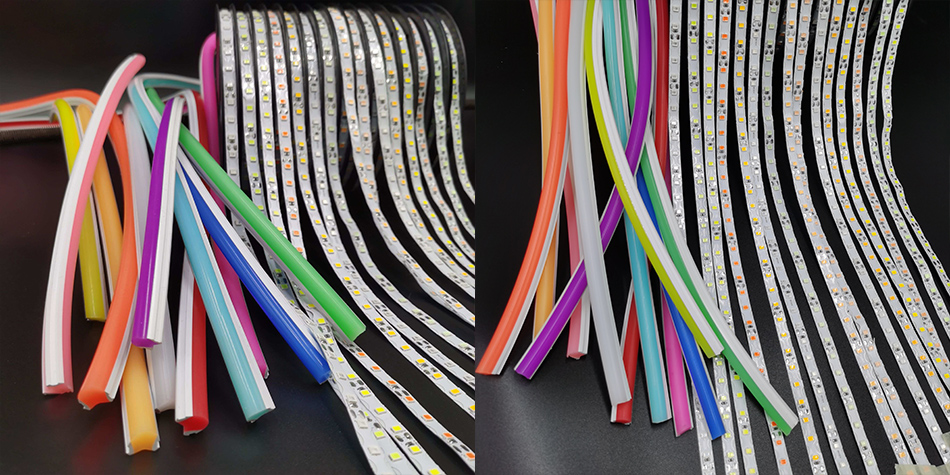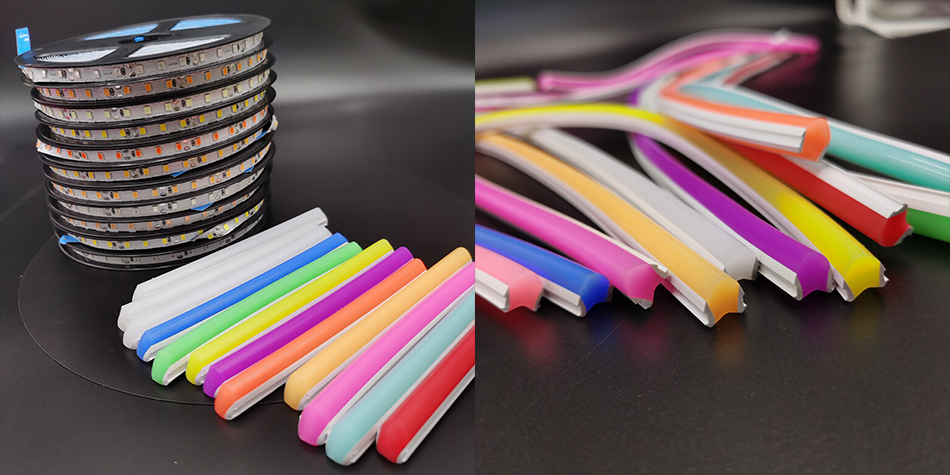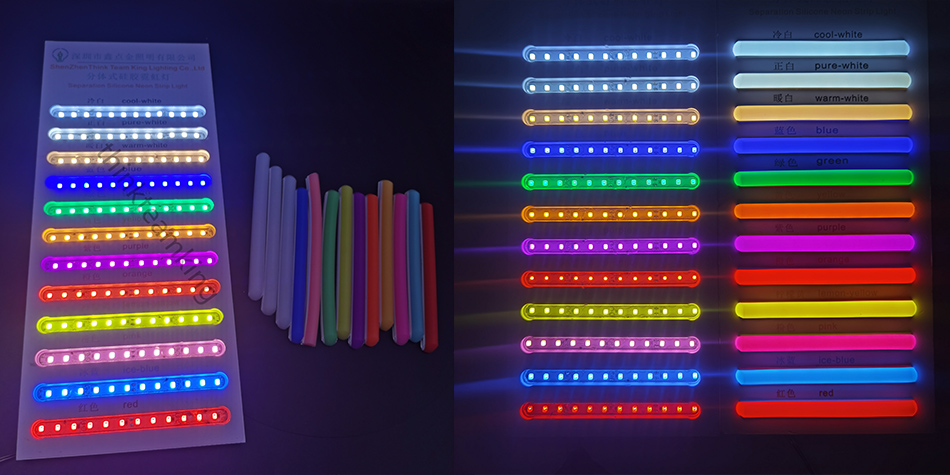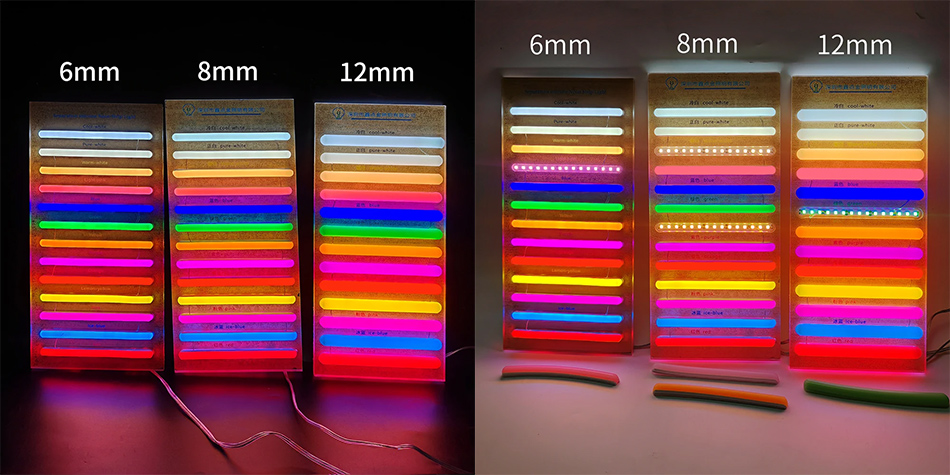Time:2025-06-20
In the dynamic landscape of contemporary lighting solutions, neon LED strip lights have emerged as a transformative force, blending the timeless allure of neon with the cutting-edge efficiency of LED technology. These strip lights have become a staple in various settings, from residential spaces seeking to enhance ambiance to commercial establishments aiming to create a distinct visual identity. Their versatility, energy efficiency, and aesthetic appeal have propelled them to the forefront of the lighting industry. This comprehensive article will explore every aspect of neon LED strip lights, from their technological foundation to practical applications and future trends.
Technological Foundations of Neon LED Strip Lights
LED Technology at the Core
At the heart of neon LED strip lights lies the advanced LED (Light-Emitting Diode) technology. LEDs operate on the principle of electroluminescence, where a semiconductor material emits light when an electric current passes through it. This direct conversion of electrical energy to light is highly efficient, significantly reducing power consumption compared to traditional lighting sources. The LED chips used in these strip lights are engineered for high brightness, long lifespan, and consistent light output, ensuring reliable performance over extended periods.
Manufacturers utilize a variety of semiconductor materials and manufacturing techniques to optimize the performance of LED chips. These advancements allow for a wide range of color emissions, from vibrant primary colors to subtle pastels, providing endless possibilities for lighting design. The miniaturization of LED chips also plays a crucial role, enabling the creation of slim and flexible strip lights that can be easily installed in diverse settings.
Mimicking the Neon Aesthetic
One of the key features of neon LED strip lights is their ability to replicate the iconic look of traditional neon lights. Through innovative optical designs and specialized diffuser materials, these strip lights produce a soft, diffused glow reminiscent of classic neon tubes. The even distribution of light across the strip creates a seamless and continuous illumination, enhancing the visual appeal.
Advanced coating and encapsulation technologies are employed to protect the LED chips and ensure a smooth light diffusion. This not only gives the strip lights the characteristic neon appearance but also provides a more comfortable and aesthetically pleasing lighting experience. The combination of LED efficiency and neon-like aesthetics makes these strip lights a popular choice for both functional and decorative lighting applications.
Electrical and Control Systems
Neon LED strip lights are equipped with sophisticated electrical and control systems to ensure optimal performance. The electrical circuitry is designed to provide a stable and consistent power supply to the LED chips, preventing flickering and ensuring uniform illumination. Advanced drivers are used to regulate the current and voltage, protecting the LEDs from damage and extending their lifespan.
In terms of control, modern neon LED strip lights offer a wide range of options. Many strip lights come with built-in dimming functions, allowing users to adjust the brightness according to their needs. Additionally, they can be integrated with external controllers, such as remote controls, smart home systems, or DMX (Digital Multiplex) controllers. This enables more advanced features, including color changing, lighting effects, and scheduling, providing users with complete control over the lighting environment.

Key Advantages of Neon LED Strip Lights
Aesthetic Versatility
Neon LED strip lights offer unparalleled aesthetic versatility. Their wide range of colors and lighting effects allow designers and homeowners to create unique and personalized lighting schemes. Whether it's a warm, cozy glow for a living room, a vibrant and dynamic display for a commercial space, or a subtle accent light for architectural features, these strip lights can adapt to any design concept.
The flexibility of the strip lights also contributes to their aesthetic appeal. They can be bent, curved, and shaped to fit various surfaces and contours, enabling creative lighting installations. From highlighting the edges of furniture and cabinets to creating intricate patterns on walls and ceilings, neon LED strip lights can transform any space into a visually stunning environment.
Energy Efficiency and Cost Savings
Energy efficiency is a major advantage of neon LED strip lights. Compared to traditional lighting sources, such as incandescent bulbs and fluorescent tubes, LEDs consume significantly less energy while delivering the same or even brighter illumination. This not only reduces electricity bills but also makes them an environmentally friendly choice, contributing to a lower carbon footprint.
The long lifespan of LED strip lights further enhances their cost-effectiveness. With a lifespan that can extend into tens of thousands of hours, these strip lights require fewer replacements, reducing maintenance costs over time. The combination of energy savings and reduced maintenance makes neon LED strip lights a cost-efficient lighting solution in the long run.
Durability and Reliability
Neon LED strip lights are designed to be durable and reliable. The use of high-quality materials and robust construction techniques ensures that they can withstand the rigors of various environments. The outer casing of the strip lights is typically made from durable materials, such as silicone or plastic, which protect the internal components from dust, moisture, and physical damage.
These strip lights are also resistant to shock, vibration, and temperature fluctuations, making them suitable for both indoor and outdoor applications. Their reliability minimizes downtime and ensures consistent performance, providing a stable lighting solution for any space.

Diverse Applications of Neon LED Strip Lights
Residential Interior Lighting
In residential settings, neon LED strip lights are widely used to enhance the ambiance and functionality of interior spaces. In the living room, they can be installed behind the TV, along the ceiling coves, or under furniture to create a cozy and inviting atmosphere. The soft glow of the strip lights can also be used to highlight architectural features, such as exposed beams or decorative moldings, adding depth and character to the room.
In the bedroom, neon LED strip lights can be placed behind the headboard, around mirrors, or under the bed to create a relaxing and romantic ambiance. They can also serve as nightlights, providing a gentle illumination without disturbing sleep. In the kitchen, these strip lights are ideal for under-cabinet lighting, providing task illumination while adding a modern touch to the space.
Commercial and Retail Spaces
For commercial and retail establishments, neon LED strip lights are a powerful marketing and branding tool. In retail stores, they can be used to create eye-catching window displays, highlight product shelves, and enhance the overall shopping experience. The ability to customize the color and lighting effects allows businesses to create a unique visual identity that attracts customers and differentiates them from competitors.
In restaurants and cafes, neon LED strip lights can be used to set the mood and create a distinctive dining atmosphere. They can be installed along the walls, around the bar area, or under the tables to create a warm and inviting environment. In offices and other commercial spaces, these strip lights can be used to decorate common areas, such as lobbies, corridors, and meeting rooms, adding a touch of creativity and professionalism.
Architectural and Landscape Lighting
In architecture, neon LED strip lights are used to accentuate the unique features of buildings. They can be installed along the edges of roofs, eaves, windows, and doors to create a striking nighttime presence. The soft, glowing lines add depth and dimension to the building's facade, enhancing its aesthetic appeal.
In landscape lighting, these strip lights are used to illuminate pathways, gardens, and outdoor structures. They can be installed along the edges of walkways, around trees and shrubs, or under benches and pergolas to create a safe and inviting outdoor environment. The flexibility of the strip lights allows for creative installations that highlight the natural beauty of the landscape.

Choosing the Right Neon LED Strip Lights
Quality and Brand Reputation
When selecting neon LED strip lights, quality should be the top priority. Look for products from reputable manufacturers that use high-quality materials and components. Check for certifications, such as UL, CE, and RoHS, which indicate that the product meets international safety and quality standards.
Reading customer reviews and testimonials can also provide valuable insights into the quality and performance of the product. A high-quality neon LED strip light will offer consistent light output, accurate color representation, and a long lifespan. It should also be backed by a reliable warranty and good customer support.
Compatibility and Connectivity
Consider the compatibility of the neon LED strip lights with your existing electrical system and any control devices you plan to use. Different strip lights may require specific power supplies, controllers, or connectors. Make sure the strip lights you choose are compatible with your power source and any dimming or color-changing devices you want to use.
If you plan to integrate the strip lights with a smart home system, ensure that they are compatible with the relevant protocols and platforms. Compatibility issues can lead to problems with installation, operation, and control, so it's important to do your research and choose products that will work seamlessly with your existing setup.
Design and Application Requirements
Based on your intended application, consider the design and features of the neon LED strip lights. For example, if you need to install the strip lights in a tight space or around sharp corners, look for a flexible and thin strip. If you want to create dynamic lighting effects, choose a strip light that supports color changing and has a wide range of lighting modes.
Also, consider the color temperature and brightness of the strip lights. Warm white colors are suitable for creating a cozy and inviting atmosphere, while cool white colors are ideal for task lighting and commercial applications. The brightness of the strip lights should be appropriate for the space and the intended use.

Installation and Maintenance of Neon LED Strip Lights
Installation Best Practices
Proper installation is essential for the optimal performance and longevity of neon LED strip lights. Before installation, carefully plan the layout of the strip lights and measure the areas where they will be installed. Clean the surfaces thoroughly to ensure a good adhesion if using adhesive - backed strips or a secure fit if using mounting clips or brackets.
When cutting the strip lights to size (if allowed by the manufacturer), use a sharp cutter and follow the manufacturer's instructions to ensure that the electrical connections remain intact. When connecting the strip lights to the power supply and control systems, make sure to follow the wiring diagrams carefully and use the appropriate connectors and wiring to ensure a safe and reliable connection.
For outdoor installations, use waterproof connectors and enclosures to protect the electrical components from moisture. Consider using additional protective measures, such as UV-resistant coatings or covers, to enhance the durability of the strip lights in outdoor environments.
Maintenance Tips
Maintenance of neon LED strip lights is relatively straightforward. Regularly inspect the strip lights for any signs of damage, such as cracks in the casing, loose connections, or a decrease in light output. If you notice any issues, turn off the power immediately and troubleshoot the problem.
Clean the strip lights gently with a soft, dry cloth to remove dust, dirt, and any other debris that may have accumulated on the surface. Avoid using abrasive cleaners or harsh chemicals, as they can damage the outer casing and the LED components. If a section of the strip stops working, first check the connections to the power supply and the control system. In some cases, a faulty connection may be the cause. If the problem persists, it may be necessary to replace the faulty section of the strip light.

Future Trends in Neon LED Strip Lights
Smart Lighting Integration
The future of neon LED strip lights lies in smart lighting integration. As the demand for smart homes and buildings grows, these strip lights are expected to be more seamlessly integrated with smart home ecosystems. This will enable users to control the lighting from anywhere using their smartphones, voice commands, or smart home hubs.
Features such as motion sensing, automatic dimming based on ambient light levels, and synchronization with music or other media are likely to become more common. Smart integration will also allow for more advanced lighting scenarios and customization, enhancing the user experience and the functionality of the lighting system.
Advancements in Materials and Manufacturing
Ongoing research and development in materials science and manufacturing technology will drive further advancements in neon LED strip lights. Newer materials with improved flexibility, durability, and light-transmission properties are likely to be developed, making the strip lights even more adaptable and long-lasting.
Manufacturing processes may become more precise and efficient, resulting in higher-quality products at more affordable prices. Additionally, innovations in the design of the lighting components, such as smaller and more powerful LED chips, may lead to even thinner and more energy-efficient strip lights in the future.
Sustainable and Eco-friendly Solutions
With increasing environmental awareness, there will be a greater focus on sustainable and eco-friendly solutions in the neon LED strip light industry. Manufacturers will likely develop products using recycled materials and more energy-efficient manufacturing processes. There will also be an emphasis on the recyclability and proper disposal of the strip lights at the end of their lifespan, reducing the environmental impact.
Conclusion
Neon LED strip lights have revolutionized the lighting industry with their unique combination of aesthetic appeal, energy efficiency, and versatility. Their wide range of applications, from residential to commercial and architectural settings, makes them an essential tool for lighting design. By understanding the technological foundations, key advantages, applications, and considerations when choosing, installing, and maintaining these strip lights, as well as keeping an eye on future trends, users can fully leverage the potential of neon LED strip lights. As technology continues to evolve, these strip lights are set to play an even more significant role in shaping the future of modern lighting, offering endless possibilities for creating beautiful and functional illuminated spaces.